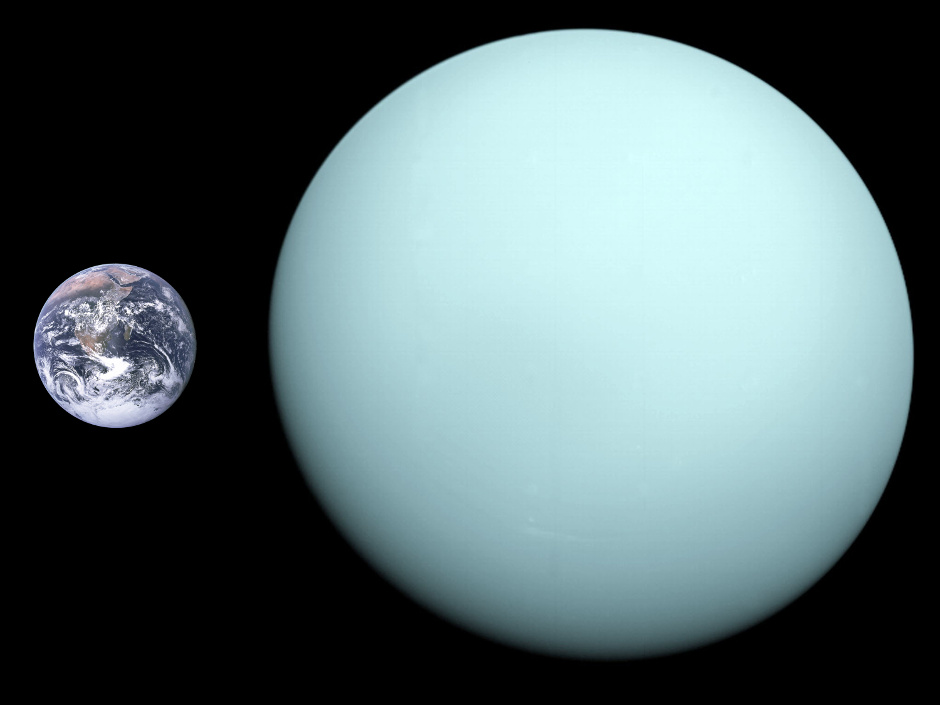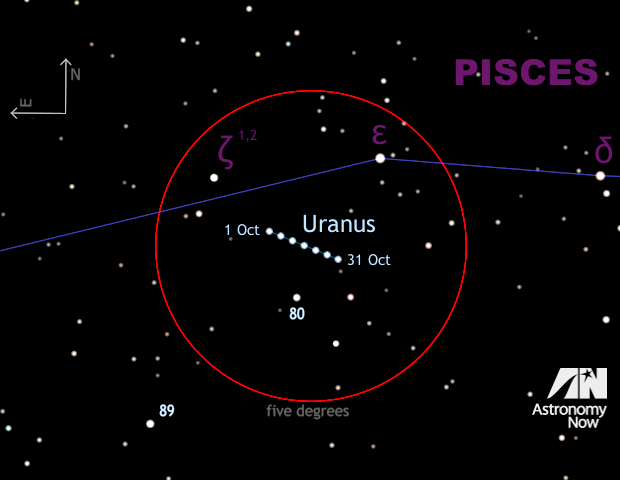On Monday, 12 October the seventh planet from the Sun, Uranus, reaches opposition in the constellation Pisces and is therefore best placed for observation during 2015. As seen from the centre of the British Isles, Uranus currently attains a maximum altitude of almost 43 degrees above the southern horizon at 1am BST. By the end of October, when the clocks have gone back one hour, Uranus will be highest in the UK sky by 10:30pm GMT.

With a diameter four times that of the Earth, Uranus is the third largest planet in the solar system. It orbits the Sun once every 84 years at a distance of 1.8 billion miles, or 19 times further away from the Sun than the Earth. Like its more distant sibling Neptune, Uranus is deemed an ‘ice giant’ because, while it is largely composed of hydrogen and helium gas like its larger kin Jupiter and Saturn, Uranus also contains methane gas plus water and ammonia in the form of ice.
At a minimum temperature of −224.2 °C, Uranus’ atmosphere is the coldest in the solar system, yet still experiences wind speeds in excess of 500 miles per hour. Furthermore, the planet’s axis of rotation (a Uranian day is 17¼ hours long) is tipped to one side — almost in the plane of its orbit. With its polar regions positioned where most planets have their equators, the seasons of Uranus are odd indeed. The planet has a retinue of 27 known moons and a system of rings that were discovered in March 1977.
A brief observing history
Uranus holds the distinction of being the first planet discovered with a telescope, by Sir William Herschel on 13 March 1781, when it was in the constellation Taurus. However, since Uranus can attain a maximum magnitude of +5.32, it can be seen with the unaided eye on moonless nights. Consequently, it was observed on a number of previous occasions by other astronomers, but mistaken for a star owing to its slow orbital motion. Uranus was seen by Astronomer Royal John Flamsteed in December 1690 who catalogued it as a star — 34 Tauri.
Somewhat embarrassingly for the French astronomer Pierre Lemonnier, records reveal that he saw Uranus on four consecutive nights and observed it at least twelve times between 1750 and 1769 without realising its planetary nature! In fairness to these eminent astronomers of yesteryear, if Uranus is observed at one of its stationary points between retrograde and prograde motion then it could easily be mistaken for a fixed star over the course of a few nights.
Uranus has five major moons which are, in order of increasing distance from the planet, Miranda, Ariel, Umbriel, Titania and Oberon. They range in size from 293 miles (472 kilometres) for Miranda up to 981 miles (1578 kilometres) for Titania. Sir William Herschel discovered Titania and Oberon in 1787, William Lassell located Ariel and Umbriel in 1851, while Gerard Kuiper discovered Miranda in 1948.
Observing Uranus with the naked eye or binoculars
Can most people see Uranus with the naked eye if they know exactly where to look? I thought it would be instructive and fun to find out. Using the chart below, find a dark location away from streetlights on a moonless night and let your eyes get dark adapted over the course of at least 15 minutes before making the attempt.
If you are slightly long-sighted (presbyopic) and wear glasses for everyday use as I do, try removing them at night — you may find that ‘night myopia’ restores your 20/20 vision for the sharpest views of the stars!
Don’t worry if you can’t see Uranus without optical aid, because even the smallest quality binocular will readily reveal it to you using the following instructions. What’s more, with binoculars you will be able to see the planet from urban areas or in moonlight later in the month.

Inside the magazine
You can find out how to observe Uranus and its brightest moons with a telescope in the October edition of Astronomy Now in addition to a full guide to the night sky.
Never miss an issue by subscribing to the UK’s biggest astronomy magazine. Also available for iPad/iPhone and Android devices.




